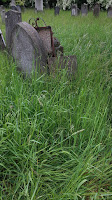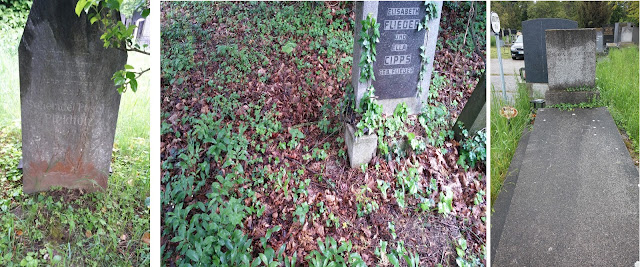 |
| Gate 4, the all-Jewish section |
The cemetery visit was cold and rainy from start to finish. But flat, with paved roads.
I shall go through them one by one, showing the pictures I took this week. Stay with me please to the end as there some really good bits of new information. Some of the graves are in Gate 1, the others are in Gate 4. The tombstones with the most important new information are presented in this blog on a yellow background.
 |
| Abraham Ahron and Josef Riss |
Abraham Ahron Riss is buried with his son Josef Riss. His wife is Breine the half sister of my great-grandfather. The tombstone also commemorates Josef's wife Franczeska who was killed later, during the Holocaust. The family replaced an older stone some years ago.
 |
| Wilhelm Riss |
Next to them to the right (here on the left) is the eldest of the Riss sons Wilhelm. There is no stone. The cemetery can make provisions for a tombstone should the family be interested
A Riss daughter, Regina is buried with her husband Dawid Gottlieb and their adult daughter Breine Ritter. Their stone is below on the left. It needs cleaned and relettered.
A grave which we had not yet identified is for Sarah Kornberg, who died in 1914 at age fifty-four. We have a person by this name but we could not identify the grave as hers with certainty. This was my first look at this stone and it definitely says "Sarah bat Peretz" which is what ours should say. The tombstone needs repair.
A few months ago, I reported that the AGAD archives received a new batch of death records for the years 1908-15 and it includes the 1915 death of fifty-nine year old Jakob Pikholz. He is Sarah's brother. According to their family's tradition, they were twins. But the ages do not match. Perhaps the actual record for Jakob will clarify this but for now all we have is the JRI-Poland index.
 |
| Greta Pikholz's grave has no stone. |
We do not know where Sarah's husband is buried.
On the left is the grave of the child Greta Pickholz. It has no stone. Greta maternal grandmother is Sarah Kornberg and her paternal grandmother is Sarah's sister Blime.
Greta's parents and six siblings were deported to Maly Trostinez in 1942 and were shot.
 |
| Peter Pickholz' stone should be between these two. |
What I did learn is that there is a large memorial near those military graves which lists the names of Austrian soldiers who died during WWI. "Pickholz P." is on that list.
Scheindel Peshe Pikholz, the daughter of David Pikholz of Rozdol and his wife Sherke Kawa, is the left of the three graves below. A translation of her epitaph is in the Virtual Cemetery.
The middle grave of the three below shows the space where Ajzer Pikholz is buried without a marker. The names of the two women in the adjacent grave.are shown in order to help locating the space. As I mentioned above, the cemetery would be happy to assist family members who wish to erect a tombstone or to repair or replace an existing stone. I discussed Ajzer (also spelled Ojzer) two months ago.
On the right below is a grave which had not been photographed for our project. Josef Pohorilles was born in 1869 in Skalat to Markus Pohorille and Alte Pikholz the daughter of Nachman Pikholz. On his birth record, it is spelled Paryle. He died in Vienna in 1957. His wife Chaje / Klara Rosenblatt died in 1962. Both are in the same grave which I did not find legible. They seem to have been childless.
We have long known of a Markus Pickholz who died in Vienna in May 1915. Cemetery records say he was twenty-four and that he was born near Tarnopol. The problem is that we have two Markus Pickholz born near Tarnopol who are close in age. The son of Josef Pickholz was born in 1889 and the son of Isaac Pickholz was born in 1892. There are two questions - which is this grave and what happened to the other Markus.
The grave photo I have had since 2000 is very poor quality and neither the cemetery itself nor the community offices has additional information. I was hoping that a visit to the grave itself might help.
As you can see here on the right, it did. This grave says Mordecai ben Yosef, which makes him a grandson of Uncle Selig whom I have mentioned many times before. I shall adjust my "Uncle Selig" presentation to include this.
The other Markus may be the father of Zisl Kling, but that is just conjecture. There are some additional possibilities.
 On Holocaust Day, a few weeks ago, I told the story of Gittel / Gusta Pickholz who was born in Tarnopol in 1901 to Meier Pickholz and Laura Spiegelglass. We have no idea - nor even a guess - who Meier's parents are. It has long bothered me that this threesome is gone without a trace and with nothing connecting them to any other Pikholz.
On Holocaust Day, a few weeks ago, I told the story of Gittel / Gusta Pickholz who was born in Tarnopol in 1901 to Meier Pickholz and Laura Spiegelglass. We have no idea - nor even a guess - who Meier's parents are. It has long bothered me that this threesome is gone without a trace and with nothing connecting them to any other Pikholz.We have a grave location for Laura (Lea) from the 2000 photographs, but when we went to the site this week, we saw nothing that looks like that. The empty space to the right of the stone in the photograph on the left is where her grave is.
We also visited Meier's grave. In this 2000 photograph, the inscription appears to have been worn away entirely. He died in December 1916 and the cemetery record says he is forty-two, i.e. born about 1874. We also have a late (1915) marriage record fron Vienna which has him born about 1872. Does that matter? You bet it does!
We found the grave just as in the photograph, but Haim suggested we do a grass rubbing and perhaps we could coax something out of the stone. For instance this:
Here lies buried
A pure and honest man
R' Meir Pickholz
ben R' Asher Selig
from Tarnopol
Died [something about a hospital?] in Vienna
17th Kislev 5677
Ben Asher Selig? Uncle Selig's son? This is the only time we have seen his name as Asher, but Selig is a standard Yiddish name for the Hebrew Asher, so it's not really a surprise.
And of course we have no other Selig Pikholz, so there is no question of identification.
The thing is Uncle Selig's wife Chana died of cancer in September 1873 at age forty five, so she could have had a son in 1872 but not 1874. Of course Meier could be from a second wife, but we have no evidence that Uncle Selig remarried and certainly none that he remarried so quickly after Chana died.
Except that Meir was born in Tarnopol and Chana died in Skalat, where the family lived. Maybe Uncle Selig married a second time, this time to a woman from Tarnopol. And they lived in her hometown. Where Meir was born.
I also wonder if Uncle Selig's granddaughter Freide Migden named her son Meir after her father's younger brother Meir. That would make sense, though they could both have been named independently for the same (unknown) person. Meir Migden's birth year is a matter of some debate but in any event it was after Uncle Selig's Meier died.
There is a lot to consider here - and significant changes to be made in my presentation. And work to do on my database and web site. But Meir, Laura and Gusta have a Pikholz family.
My trip was planned around selected locations in Slovakia and Hungary and then I added Nuremberg. Vienna was nothing more than an afterthought. Three major successes and any one of them would have made the visit worthwhile.
People ask why should they look for a document or visit a cemetery or take a DNA test.
"What are you looking for?"
"What are you trying to prove?"
The answer is that I don't always know. I'll find out when I see the evidence or the test results or the photographs. Vienna was mostly a courtesy visit but Vienna returned the courrtesy with significant information about Meier and Markus Pickholz and Sarah Kornberg. Information that told us who they are in the family structure.
I also hope that some of my readers and family members will at least speak to the cemetery people about the missing tombstones and those that need repaired or replaced.
A wildly successful conclusion to a wildly successful trip.
(Note: I intended to spend my final day in Vienna at the offices of the the Jewish Community, but considering that no one answered my inquiries about anything, I figured I would get more done just catching up with myself. I have much to catch up with.)







Were you in the old Jewish cemetery or the new? When I was there, it was Sukkot, so the new Jewish cemetery was closed. The old Jewish cemetery was a nightmare, no directional markers, overgrown vines, and fallen head-stones. All this was a contrast to the orderly, well-manicured, and predominantly non-Jewish graves of the rest of this massive cemetery.
ReplyDeleteSome of them were in gate 4, the newer part. The best were in Gate 1, the older part. The older part is part Jewish and part non-Jewish, so it would be open on Jewish holidays.
DeleteIzik Popper suggested in an email that the unclear line in Meier's stone says "Died in exile, here in Vienna." That looks right to me.
ReplyDelete